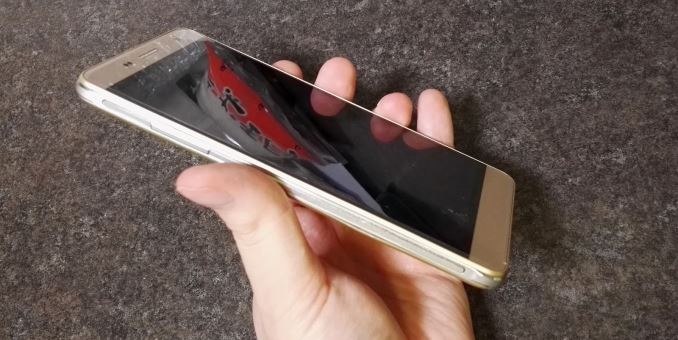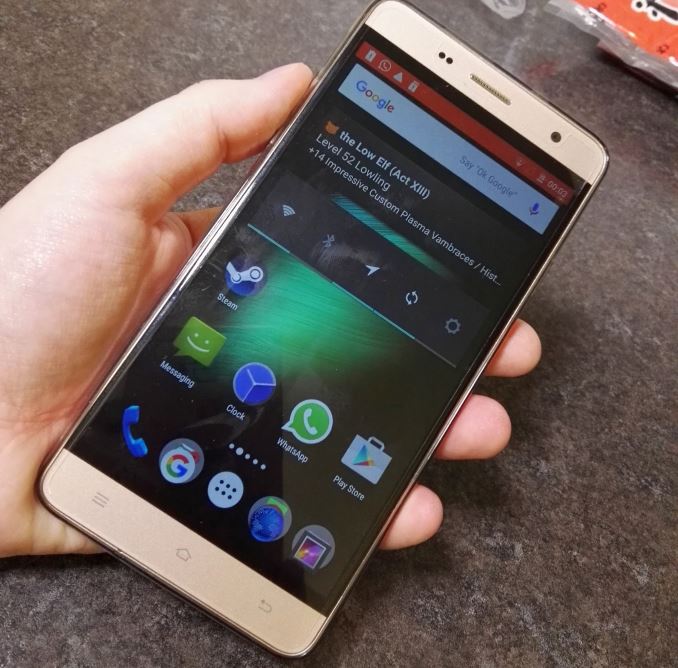The CUBOT H1 Smartphone Test: A Month with 3-4 Days of Battery per Charge
by Ian Cutress on December 23, 2015 9:01 AM EST- Posted in
- Smartphones
- Mobile
- Battery
- CUBOT
Final Words
I'll be brutally honest - while I keep a good tab on some elements of the smartphone market, more so on the business side, when it comes to deep dive analysis I leave it in the hands of Josh, Andrei and Brandon. That doesn't mean I don't need a device though, and despite their suggestions it seems I wanted a lot and wasn't prepared to spend the money. As a technical editor, my search for a smartphone caused a series of positive and negative feedback loops - some days I'd decide that DRAM was the most important, whereas others it would be the display resolution or the storage capacity. In the end it comes down to compromise and what is good and within range at the time I was looking. At one point I was adamant I wanted something more powerful than a Snapdragon 600 series, but I've ended up with a quad core MediaTek A53 device running at low frequency. There were some no-brainers – it had to be big enough and good enough to work on when I have short 20 minute public transport trips, and support dual SIM so I don’t have to keep losing my SIM card each time I travel.
The CUBOT H1 was the result of the search. It’s a smartphone that boasts 5200 mAh of battery, which is 3.4x the size of the battery in the iPhone 5c or 2x the battery in the Galaxy S6. When combined with the 1280x720 screen and the 1 GHz quad-core SoC, it gave 4 days of standard use battery which translated to 15 hours and 26 minutes on the PCMark battery test that runs from 100% to 20%, beating the Zenfone 2 by over nine hours. That is pretty much pre-2000 smartphone territory, more akin to what we used to have when playing games like Snake.
My smartphone use case has adapted over time – I want it to do work on. That means writing, switching between apps, being somewhat responsive, and always being available. The SoC means it doesn’t break any sort of record for performance, but ultimately so much of my use doesn’t require performance but rather latency in app switching and updates. Having enough memory to keep apps available means a lot, so moving up from 1GB to 2GB was a big enough change to notice, as well as the bump up to Android 5.1. The 16GB storage model is pretty basic, and the microSD compatibility is only at 32GB, rather than something bigger, and I know it will fill over time with the consistent photographing of my cats. But that is a risk that I’m going to have to take, or synchronize with Dropbox.
Without the silicone case that comes free with the phone, I will grant that despite the patterned edge, it does feel like the plastic the rear is made from, and arguably it slips out of the hand too easily. With the silicone case, it just feels like a smartphone with a case, which a lot of people use anyway. The raised power and volume buttons helps discern their location, and the fixed buttons is something I like to have on my device, even if it means giving up screen real estate.
It is clear that the cameras are not for taking glamour shots. But at a trade show, as long as you are in the front row, and have a second or two between shots, taking pictures of slides to work on later is good enough. To get a good shot taking advantage of the EIS though, you really need to use the burst mode which supports 40 shots at 13 MP each. The video is also an afterthought. That comes down to the price and what needs to be cut to meet that price. I purchased the device, brand new from Amazon, for £125 which translates to $160 pre-tax. Almost everyone I showed the phone to, probably due to the battery life argument, thought it was more expensive. The only people who guessed under (and only by $10) were a pair of senior ARM employees. But truth be told, I could buy four of these a year and it would still be cheaper than an S6. Of course, there are obvious caveats with that comparison.
I would say that this is going to be my phone for the next two years. But since I purchased it in October, two extra high end smartphones that others at AnandTech have tested have both landed on my desk for similar experiential testing. It almost seems sad to shelve the Cubot H1 immediately unless I adapt to carry two phones at once, with the H1 as that long-battery backup.
| CUBOT H1 | ||
| SoC | Mediatek MT6735P 4x ARM Cortex-A53 at 977 MHz ARM Mali-T720 MP2 at 400 MHz |
|
| RAM | 2GB LPDDR3 at 533 MHz | |
| Storage | 16GB NAND | |
| Display | 5.5” 720p IPS | |
| Modem | 2G / 3G / 4G LTE UE Category 4 DC-HSPA+, TD-SCDMA, CDMA2000 1x/EVDO Rev. A, EDGE |
|
| Networks |
TDD LTE | None |
| FDD LTE | B1 / B3 / B7 / B20 | |
| UMTS | 900 / 1900 / 2100 | |
| GSM | 850 / 900 / 1800 / 1900 | |
| Dimensions | 154.5 (h) x 76.6 (w) x 9.2 (d) mm, 201 grams* Weight Measured by AnandTech, conflicting numbers online |
|
| Cameras | Rear | 12.8MP ( 4128 x 3096 ) |
| Front | 8MP ( 3264 x 2448 ) | |
| Battery | 5200 mAh (19.76 Whr) | |
| OS | Android 5.1 | |
| Connectivity | 802.11a/b/g/n 2.4GHz BT 4.0, GPS, A-GPS, Micro-USB |
|
| SIM Size | Micro-SIM (FDD-LTE, WCDMA, GSM) Nano-SIM (GSM Only) Also Separate MicroSD slot, up to 32GB |
|
| MSRP (UK) | 16GB | $160
£125 as purchased |
So the final question becomes ‘how is it pronounced?’ Do we say cue-bot? Or perhaps cub-bot, or cue-bow? After writing this review, and looking at their online ‘CUBOT enterprise propaganda film’ on YouTube, it turns out to be coo-bot.












116 Comments
View All Comments
raja_jagadeesan - Wednesday, December 23, 2015 - link
Fascinating review. Thanks for exploring one of these no-name knockoffs. Amazing what can be had at this price point, and even more amazing that it can offer a surprisingly good experience, and even some things - like crazy battery life - that the high-end phones can't.A very useful review - thanks anandtech for doing things like this.
benedict - Wednesday, December 23, 2015 - link
The Chinese manufacturers provide phones with amazing value for the price. I bought a Meizu M2 Note for 150$ and I'm amazed how good a 150$ phone can be. Also in that price range are Xiaomi Redmi Note 3 and Lenovo K3 Note. All of those feature great midrange specs and unless you really stress your phone those 8-core Mediatek cpus do a great job.ruthan - Wednesday, December 23, 2015 - link
I looked for new phone 2 month ago, i wanted 4 inch phone with not more weight that 115g, i ended with Galaxy S4 mini.I didnt care about money - but more powerful phone with same form factor doesnt exist - or doesnt exist in PhoneArena database.. It was big compromise - performace is limited, 8 GB storage is pain in ass and MHL is missing, but still better than 200 gram brick in my pocket..
PrinceGaz - Thursday, December 24, 2015 - link
Fellow S4 Mini user here; great small and light phone whose main drawback I find is the 8GB storage. Even after rooting and using something like Folder Mount to link app folders to an SD card, as well as moving the apps to SD using the normal method, that 8GB is still a squeeze.I reckon its performance is pretty good actually; its 1.7 GHz dual-core Krait 300 will outperform the 1.4 GHz or thereabouts quad-core A53 you'll find on similar small phones in most real-world situations, though it's probably better not to use it for demanding games as the GPU is rather lacking.
Weight as well as cost was a major factor in my going for the S4 Mini, but if your weight budget extended slightly to 130g, then nothing currently available beats the Sony Z3 Compact-- an absolute beast, albeit at a much higher price.
Sttm - Wednesday, December 23, 2015 - link
3-4 day battery life just doesn't seem as important now that we have fast charging, wireless charging, and in a lot places now convenient charging ports.amdwilliam1985 - Thursday, December 24, 2015 - link
speak for yourself, I take extreme battery life (3 to 7 days) over fast charging any day.blzd - Thursday, December 24, 2015 - link
Not if it means 5 year old performance and phone quality.A Moto G with 2400mAh or so already lasts 2 days easily with 5+ hours SoT, but doesn't have quick charge.
2 day battery life with quick charging is more than enough. How often do you go 2 days away from an outlet?
Currently rapid charging is getting devices to about 50% in 30 minutes of charging or less.
MikeMurphy - Thursday, December 24, 2015 - link
Lenovo recently released some interesting budget options with very large batteries, too. Anandtech should do a battle of the jumbo batteries.NZtechfreak - Thursday, December 24, 2015 - link
What is your 64gb card formatted to? I expect this phone will take cards of any size if they are formatted to Fat32. For reference I've used 128gb Fat32 formatted cards with things like my old 808, and used a Fat32 formatted 64gb drive with devices as old as my N82 and N95.PrinceGaz - Thursday, December 24, 2015 - link
I was going to ask that too. My Tesco Hudl2 tablet (a UK-only device) officially only supports up to 32GB cards, and couldn't read my 64GB SDXC card when I put it in, but did provide an option to format it. After doing that, it was FAT32 and could use the whole 64GB. If the Cubot doesn't provide an option to format the card, you could always format it on your PC to the desired FS using something like MiniTool Partition Wizard Free.